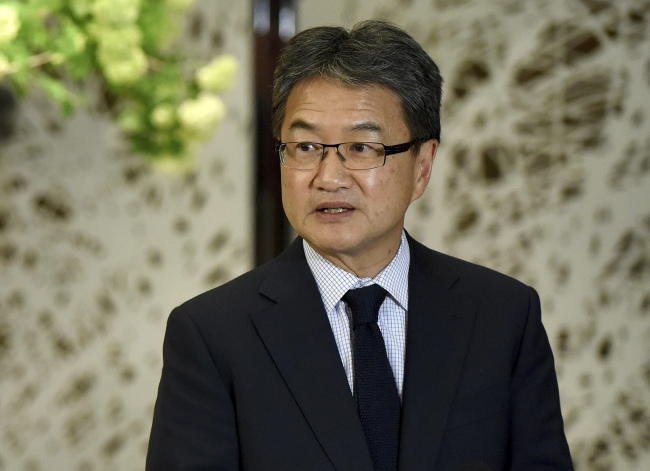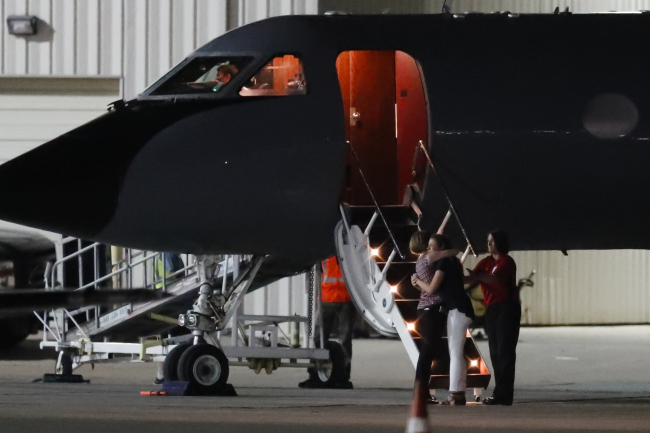It took months of “quiet diplomacy,” a change in US presidents and an American diplomat’s extraordinary, secret visit to Pyongyang to bring Otto Warmbier home.
US special envoy Joseph Yun was a household name to almost no one before Warmbier’s return to Ohio on Tuesday, yet he joins an exceedingly short list of US officials to set foot in furtive North Korea in recent years. The last such visit is believed to have been in November 2014, when former National Intelligence Director James Clapper brought home two other jailed Americans.
 |
Joseph Yun (AP-Yonhap) |
New details that emerged Thursday about Yun’s brief visit to the North Korean capital illustrate the deep level of estrangement between the US and North Korea, two countries that don’t have diplomatic relations and have technically been in a state of war for more than half a century, despite the armistice that ended the Korean War.
When Yun finally laid eyes on the comatose Warmbier in a North Korean hospital, it was the first time the US could verify his condition in person since his sentencing more than a year earlier, the State Department said.
For Yun, a longtime Asia hand who joined the foreign service in 1985, the trip was the culmination of a series of delicate and rare conversations between the US and North Korean officials that transpired since President Donald Trump took office. They started in Norway, playing the role of neutral third party, and moved to New York, where North Korean diplomats are accredited at the United Nations.
Warmbier, 22, spent almost a year-and-a-half in captivity after being arrested in January 2016. The North accused the University of Virginia student of entering the country under the guise of a tourist and plotting against the nation’s unity with “the tacit connivance of the US government.”
Paraded before the media a month later in Pyongyang, he tearfully apologized for attempting to steal a political banner from a staff-only section of his hotel. The Swedes, who represent US interests in North Korea, managed to visit him in March 2016, a few weeks before he was sentenced to 15 years hard labor.
What happened next, and how Warmbier ended up in a coma, is still unclear. Warmbier’s family said North Korea insist the coma was the result of botulism and a sleeping pill. But the family wasn’t buying the explanation. Doctors treating him in the US said they found no evidence of botulism, but did find severe brain damage consistent with losing oxygen to the brain.
 |
Two people hug outside the plane carrying Otto Warmbier, a 22-year-old University of Virginia undergraduate student who was imprisoned in North Korea in March 2016, before he is transferred from a transport aircraft to an ambulance at Lunken regional airport, Tuesday, June 13, 2017. (AP-Yonhap) |
Though Warmbier supposedly had been in a coma for more than a year, the US didn’t learn the full extent of his condition until Yun and the doctors saw him in a Pyongyang hospital.
In February, Secretary of State Rex Tillerson briefed Trump on the Americans held in North Korea. Trump directed him to do everything possible to secure their release. The State Department called the effort “quiet diplomacy” at a time of North Korean missile tests and increasing US pressure on Kim Jong Un’s totalitarian government.
In May, Yun met in the Norwegian capital of Oslo with senior officials from North Korea’s Foreign Ministry. The North Koreans agreed to let Swedish diplomats visit the US detainees, including Warmbier. Shortly after the Swedish visits, the North reached out to the US with an urgent request to meet in person, officials said.
Yun met with the North Korean ambassador to the U.N. in New York on June 6 and was told of Warmbier’s medical status. Over the next days, officials said, Tillerson and Trump discussed the case. Tillerson then dispatched Yun to North Korea “with the intent of bringing Otto back to the United States,” according to a White House timeline.
It’s unclear if Yun knew as he set off for North Korea that he’d be allowed to bring Warmbier home.
“I know the answer to that,” State Department spokeswoman Heather Nauert said _ but then she wouldn’t say. “Some of these, as I hope you can try to understand, are sensitive, diplomatic matters.”
Yun boarded a private aircraft along with two doctors and arrived Monday in Pyongyang, where they were met by North Korean officials and saw Warmbier in a hospital. Yun demanded his release, the White House claimed. The next day, Warmbier was flown to a US base in Japan before making the longer journey to Ohio to be reunited with his family.
US officials wouldn’t say if Yun met with other North Korean diplomats while in the country or conducted more extensive diplomacy. He hasn’t spoken to the media since returning and US officials have referred most questions to Warmbier’s family.
But Yun managed to see the other three detained Americans while in Pyongyang, providing the US with much-sought information about their condition. The US wouldn’t publicly describe their condition.
Though former President Barack Obama’s administration tried, too, to secure Warmbier’s release, it wasn’t enough, Warmbier’s father, Fred, said Thursday.
He said he and his wife grew frustrated with the lack of progress and with the Obama administration’s instructions not to talk about their son’s case publicly out of concern it would upset the North and make a release less likely.
Fred Warmbier, in an emotional news conference in Ohio, did not demur when asked if Obama could have done more.
“I think the results speak for themselves,” he said. (AP)









![[Today’s K-pop] Blackpink’s Jennie, Lisa invited to Coachella as solo acts](http://res.heraldm.com/phpwas/restmb_idxmake.php?idx=644&simg=/content/image/2024/11/21/20241121050099_0.jpg)